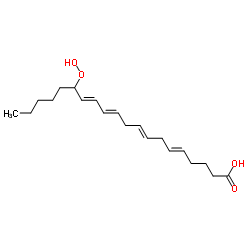15-hydroperoxy-5,8,11,13-eicosatetraenoic acid

15-hydroperoxy-5,8,11,13-eicosatetraenoic acid structure
|
Common Name | 15-hydroperoxy-5,8,11,13-eicosatetraenoic acid | ||
|---|---|---|---|---|
| CAS Number | 70981-96-3 | Molecular Weight | 336.466 | |
| Density | 1.0±0.1 g/cm3 | Boiling Point | 518.0±50.0 °C at 760 mmHg | |
| Molecular Formula | C20H32O4 | Melting Point | N/A | |
| MSDS | USA | Flash Point | 175.6±23.6 °C | |
| Symbol |


GHS02, GHS07 |
Signal Word | Danger | |
|
The human serum metabolome.
PLoS ONE 6(2) , e16957, (2011) Continuing improvements in analytical technology along with an increased interest in performing comprehensive, quantitative metabolic profiling, is leading to increased interest pressures within the metabolomics community to develop centralized metabolite ref... |
|
|
Novel role of lipoxygenases in the inflammatory response: promotion of TNF mRNA decay by 15-hydroperoxyeicosatetraenoic acid in a monocytic cell line.
J. Immunol. 174(6) , 3169-72, (2005) The metabolism of arachidonic acid via the lipoxygenase and cyclooxygenase pathways generates metabolites that regulate the inflammatory response. Although products of lipoxygenase are classically proinflammatory, recently it has been demonstrated that lipoxi... |
|
|
Nature of the cardiomyocyte injury induced by lipid hydroperoxides.
Cardiovasc. Res. 30(5) , 648-55, (1995) As a result of oxidative stress to membrane lipid matrix, the peroxidation of polyunsaturated fatty acids induced the transient formation of lipid hydroperoxides (ROOH). The aim of this study was to evaluate the damaging effects of ROOH on the cardiac cell an... |
|
|
On the relationships of substrate orientation, hydrogen abstraction, and product stereochemistry in single and double dioxygenations by soybean lipoxygenase-1 and its Ala542Gly mutant.
J. Biol. Chem. 280(46) , 38756-66, (2005) Recent findings associate the control of stereochemistry in lipoxygenase (LOX) catalysis with a conserved active site alanine for S configuration hydroperoxide products, or a corresponding glycine for R stereoconfiguration. To further elucidate the mechanisti... |
|
|
Liquid chromatography/mass spectrometry analysis of bifunctional electrophiles and DNA adducts from vitamin C mediated decomposition of 15-hydroperoxyeicosatetraenoic acid.
Rapid Commun. Mass Spectrom. 19(6) , 849-58, (2005) Reactive oxygen species convert the omega-6 polyunsaturated fatty acid arachidonic acid into 15-hydroperoxy-5,8,11,13-(Z,Z,ZE)-eicosatetraenoic acid (15-HPETE). Cyclooxygenases and lipoxygenases can also convert arachidonic acid into 15-HPETE. Vitamin C media... |
|
|
Conditional expression of 15-lipoxygenase-1 inhibits the selenoenzyme thioredoxin reductase: modulation of selenoproteins by lipoxygenase enzymes.
J. Biol. Chem. 279(27) , 28028-35, (2004) The selenoenzyme thioredoxin reductase regulates redox-sensitive proteins involved in inflammation and carcinogenesis, including ribonucleotide reductase, p53, NFkappaB, and others. Little is known about endogenous cellular factors that modulate thioredoxin r... |
|
|
Mechanistic investigations of human reticulocyte 15- and platelet 12-lipoxygenases with arachidonic acid.
Biochemistry 48(26) , 6259-67, (2009) Human reticulocyte 15-lipoxygenase-1 (15-hLO-1) and human platelet 12-lipoxygenase (12-hLO) have been implicated in a number of diseases, with differences in their relative activity potentially playing a central role. In this work, we characterize the catalyt... |
|
|
Rabbit aorta converts 15-HPETE to trihydroxyeicosatrienoic acids: potential role of cytochrome P450.
Arch. Biochem. Biophys. 420(1) , 142-52, (2003) Previous work showed that rabbit aorta metabolizes arachidonic acid via 15-lipoxygenase to 15-hydroperoxyeicosatetraenoic acid (15-HPETE), which undergoes an enzymatic rearrangement to 11-hydroxy-14,15-epoxyeicosatrienoic acid (11-H-14,15-EETA) and 15-hydroxy... |
|
|
Reaction mechanisms of 15-hydroperoxyeicosatetraenoic acid catalyzed by human prostacyclin and thromboxane synthases.
Arch. Biochem. Biophys. 461(2) , 159-68, (2007) Prostacyclin synthase (PGIS) and thromboxane synthase (TXAS) are atypical cytochrome P450s. They do not require NADPH or dioxygen for isomerization of prostaglandin H(2) (PGH(2)) to produce prostacyclin (PGI(2)) and thromboxane A(2) (TXA(2)). PGI(2) and TXA(2... |
|
|
Reduction of fatty acid hydroperoxides by human parotid saliva.
Lipids 28(2) , 121-4, (1993) Arachidonic acid hydroperoxide (15-hydroperoxyeicosatetraenoic acid; 15-HPETE) was introduced into human parotid saliva and incubated at 37 degrees C. Straight phase high-performance liquid chromatography analysis of the reaction mixture showed that 15-HPETE ... |